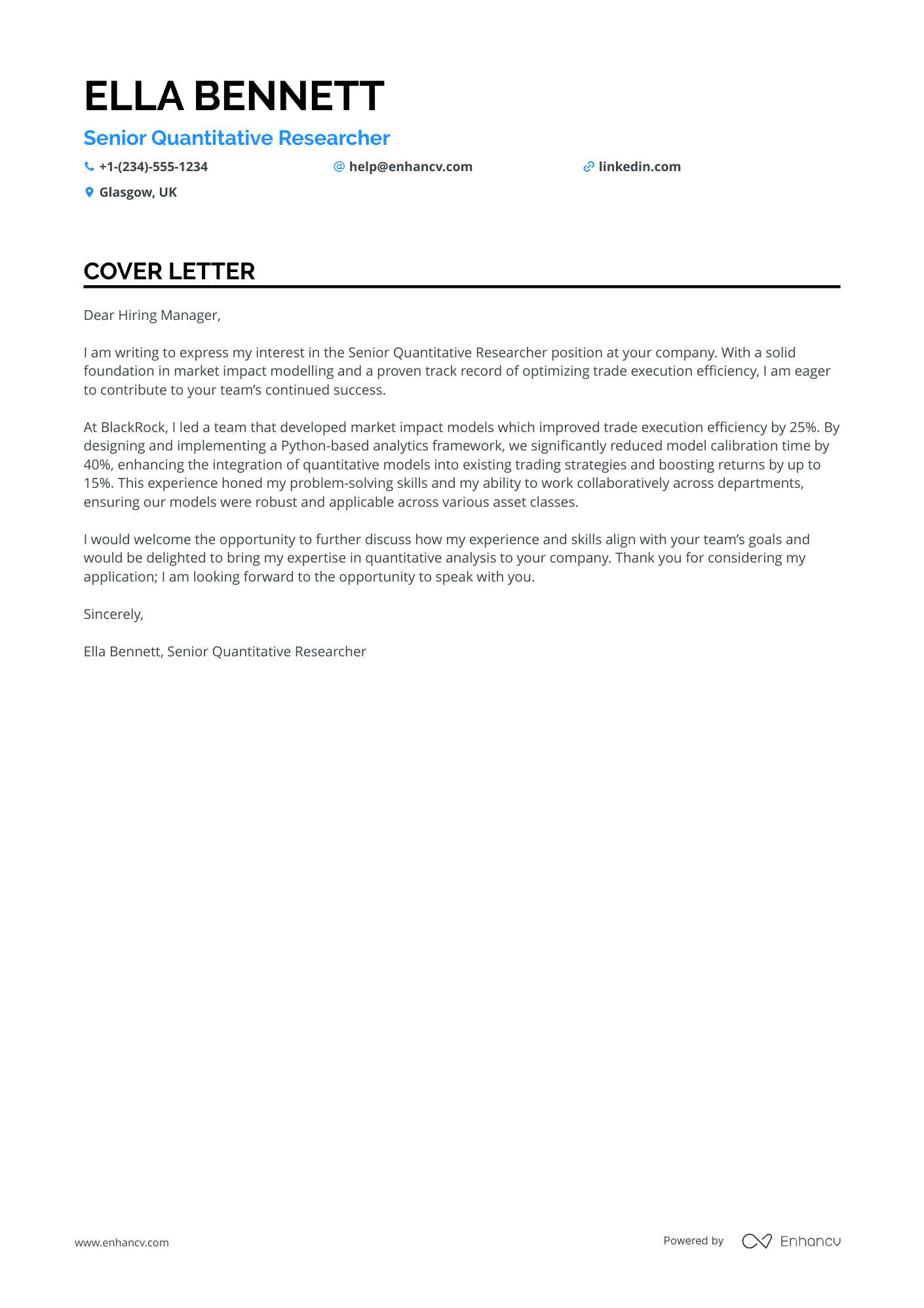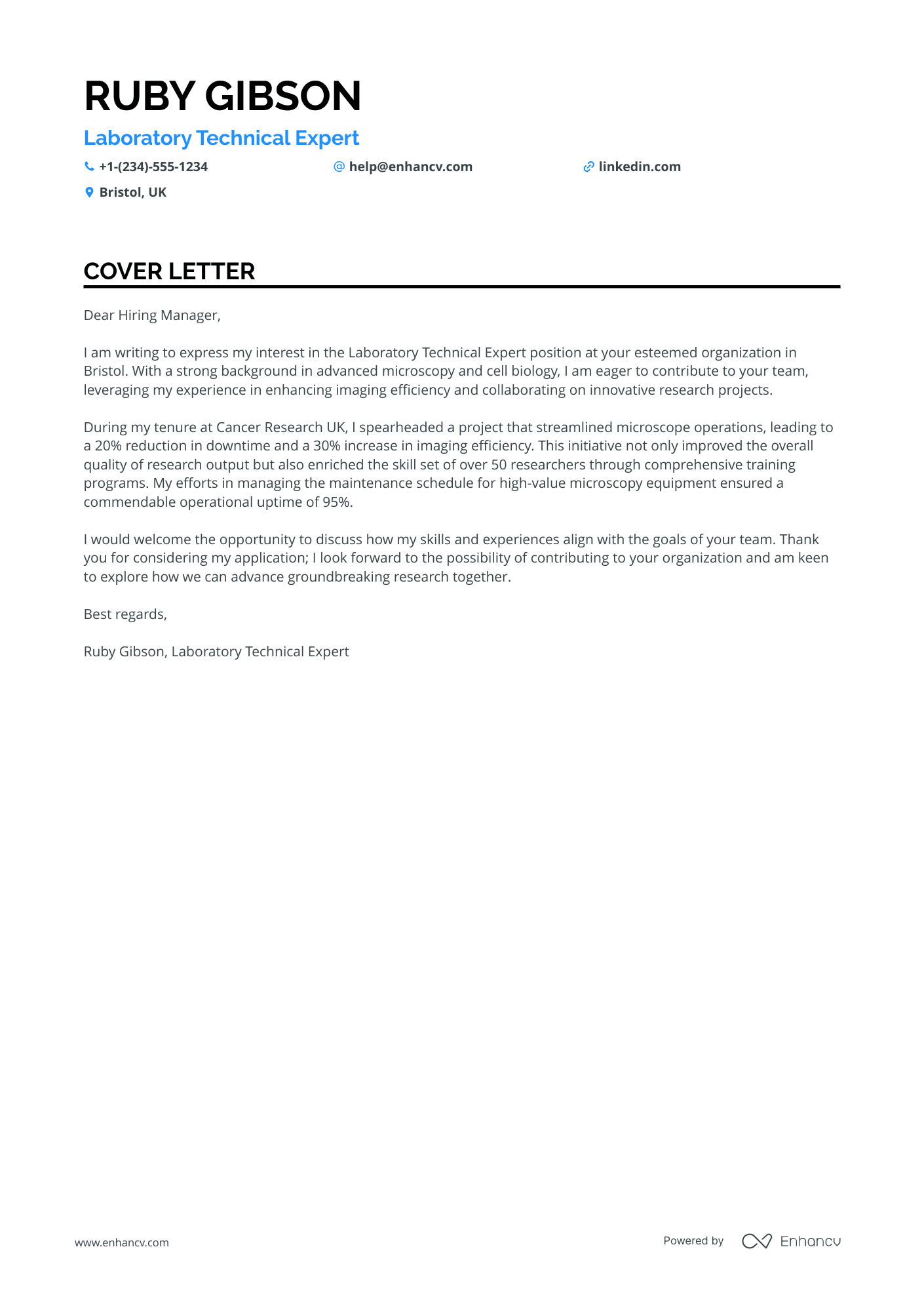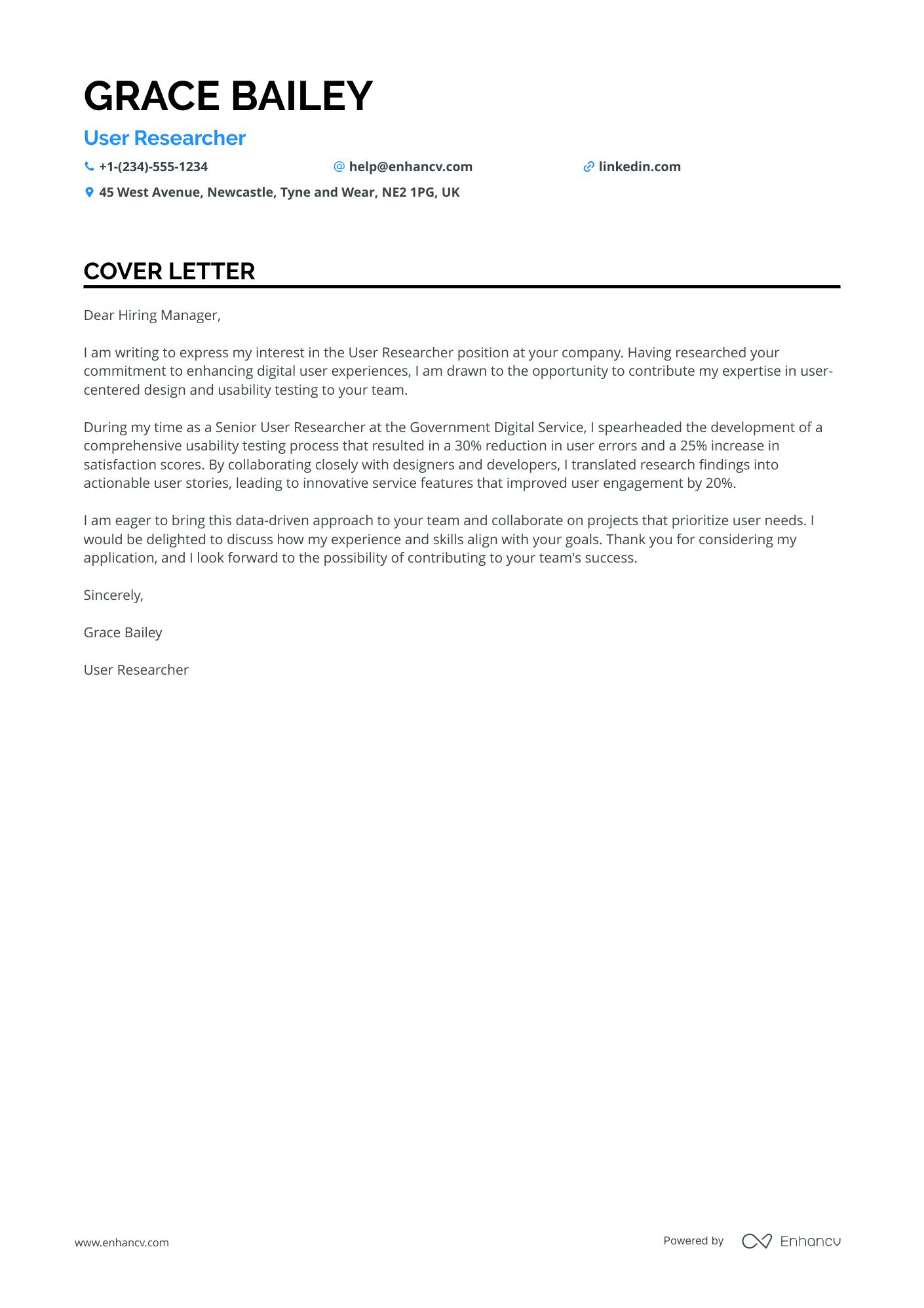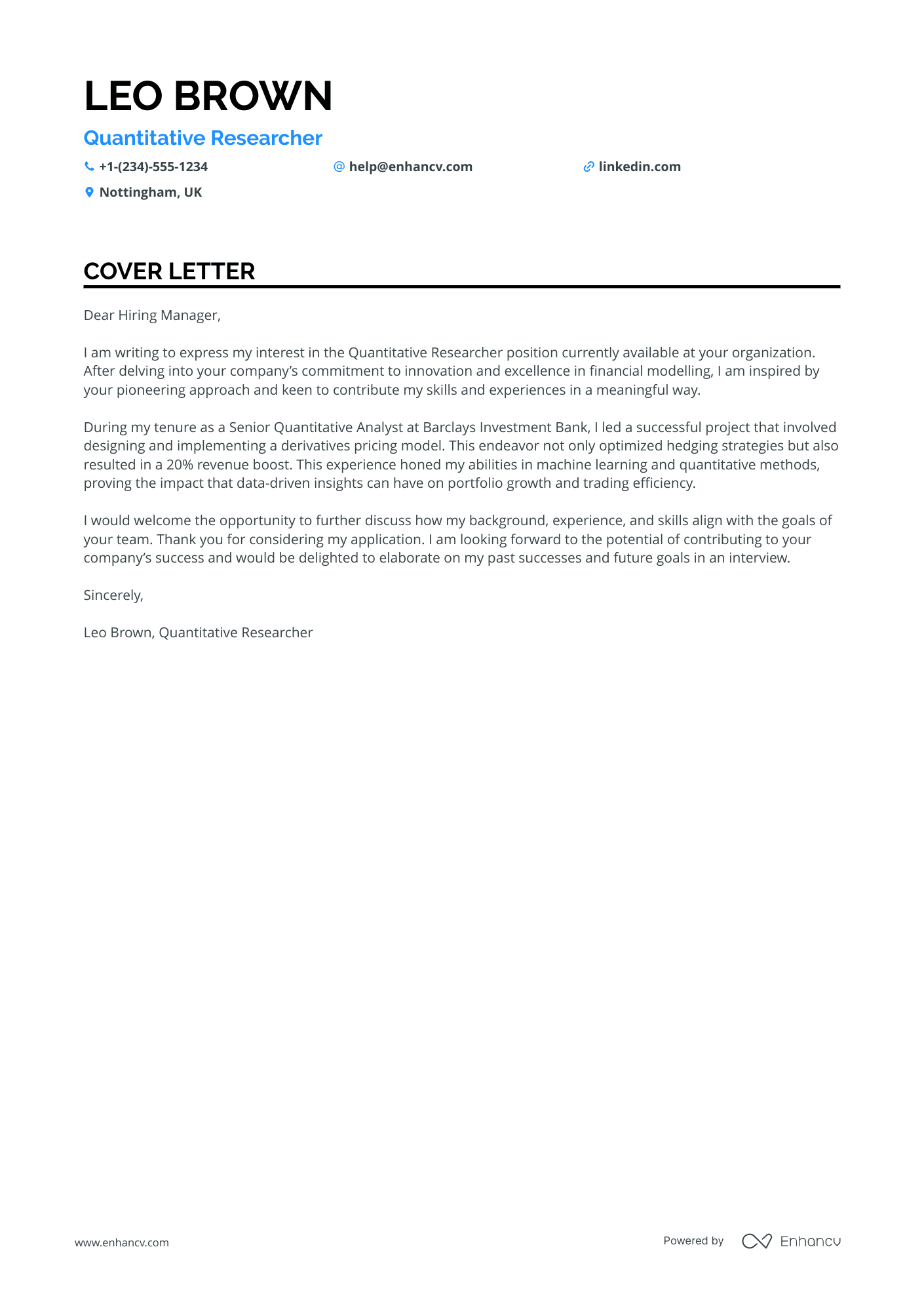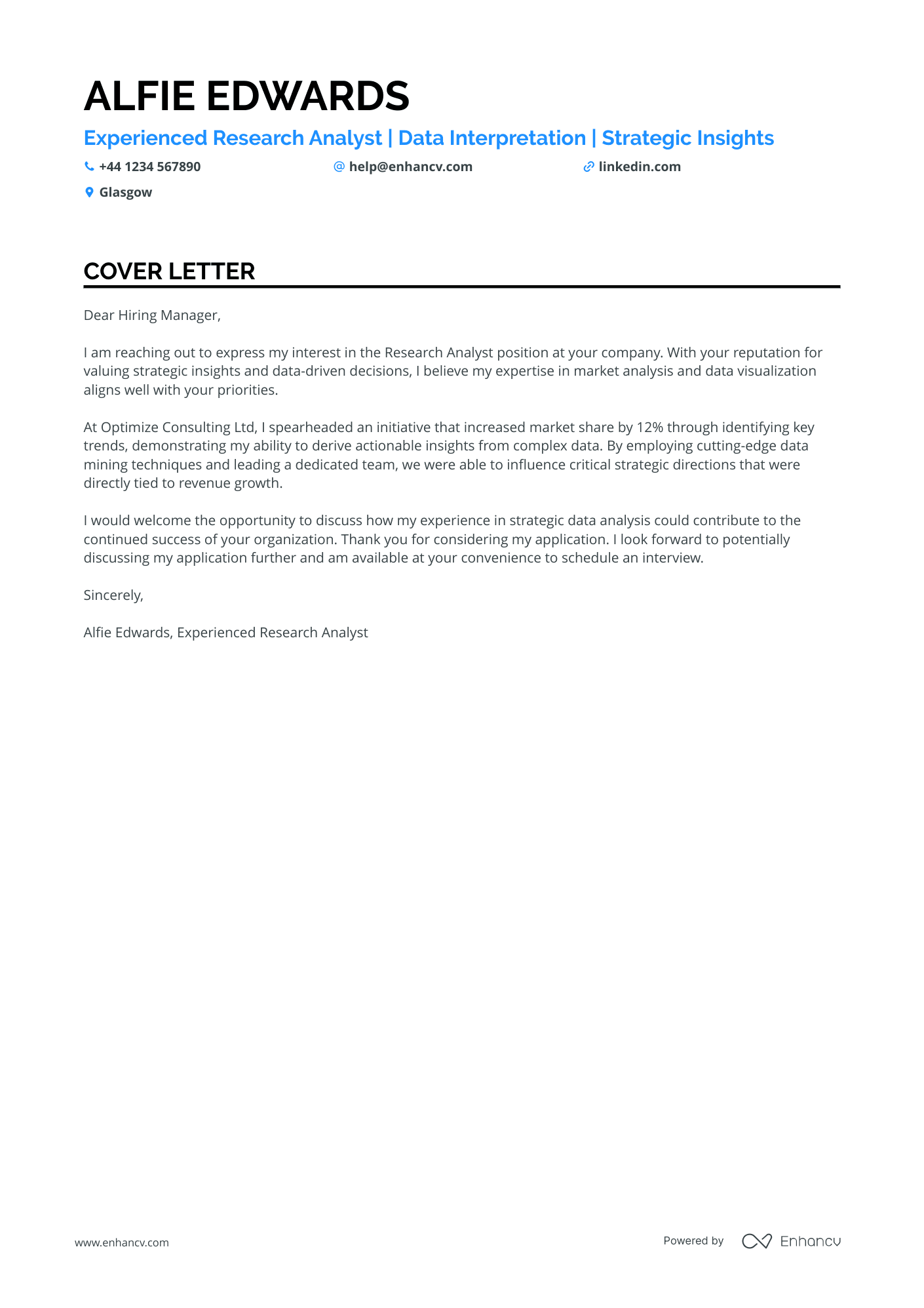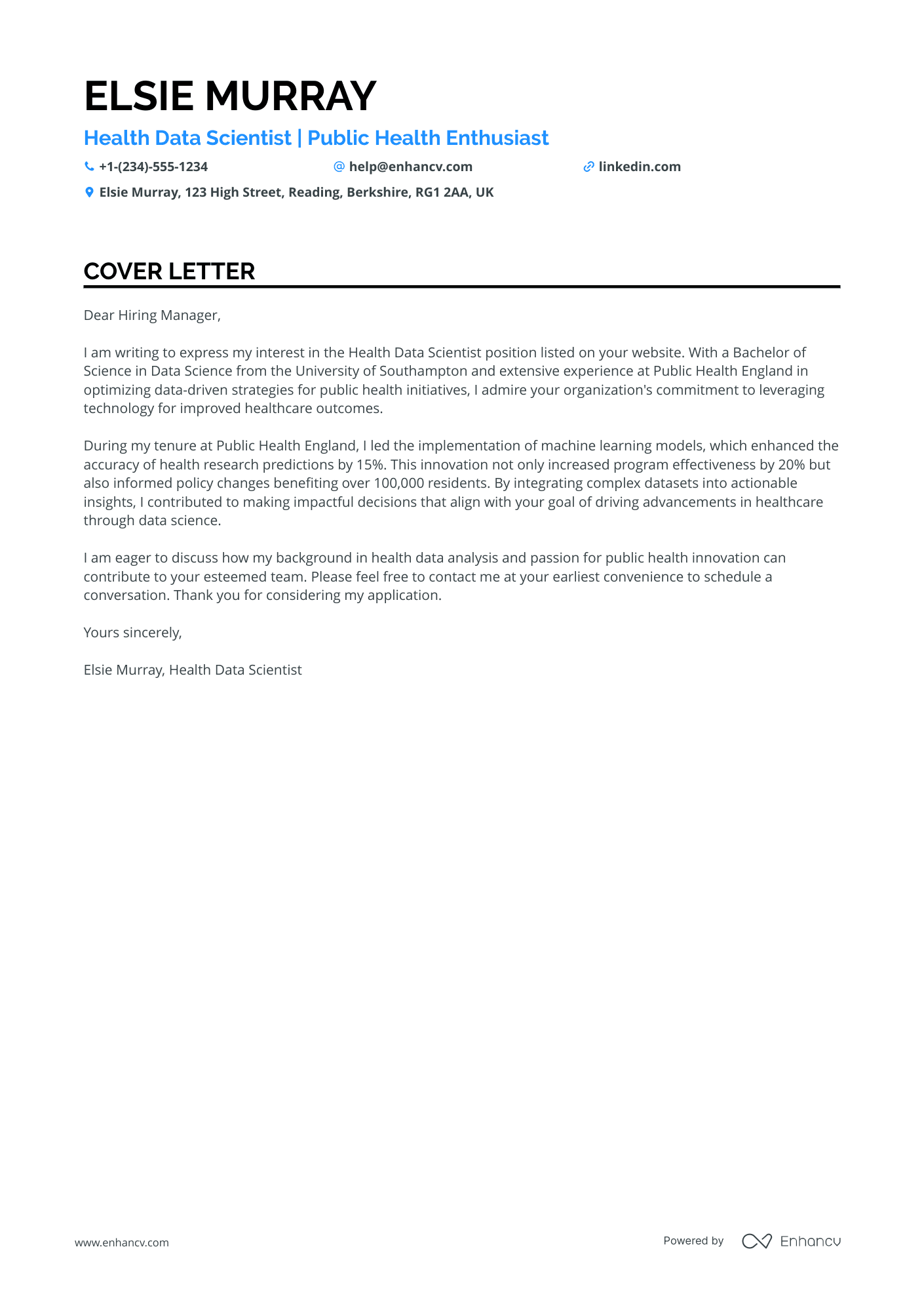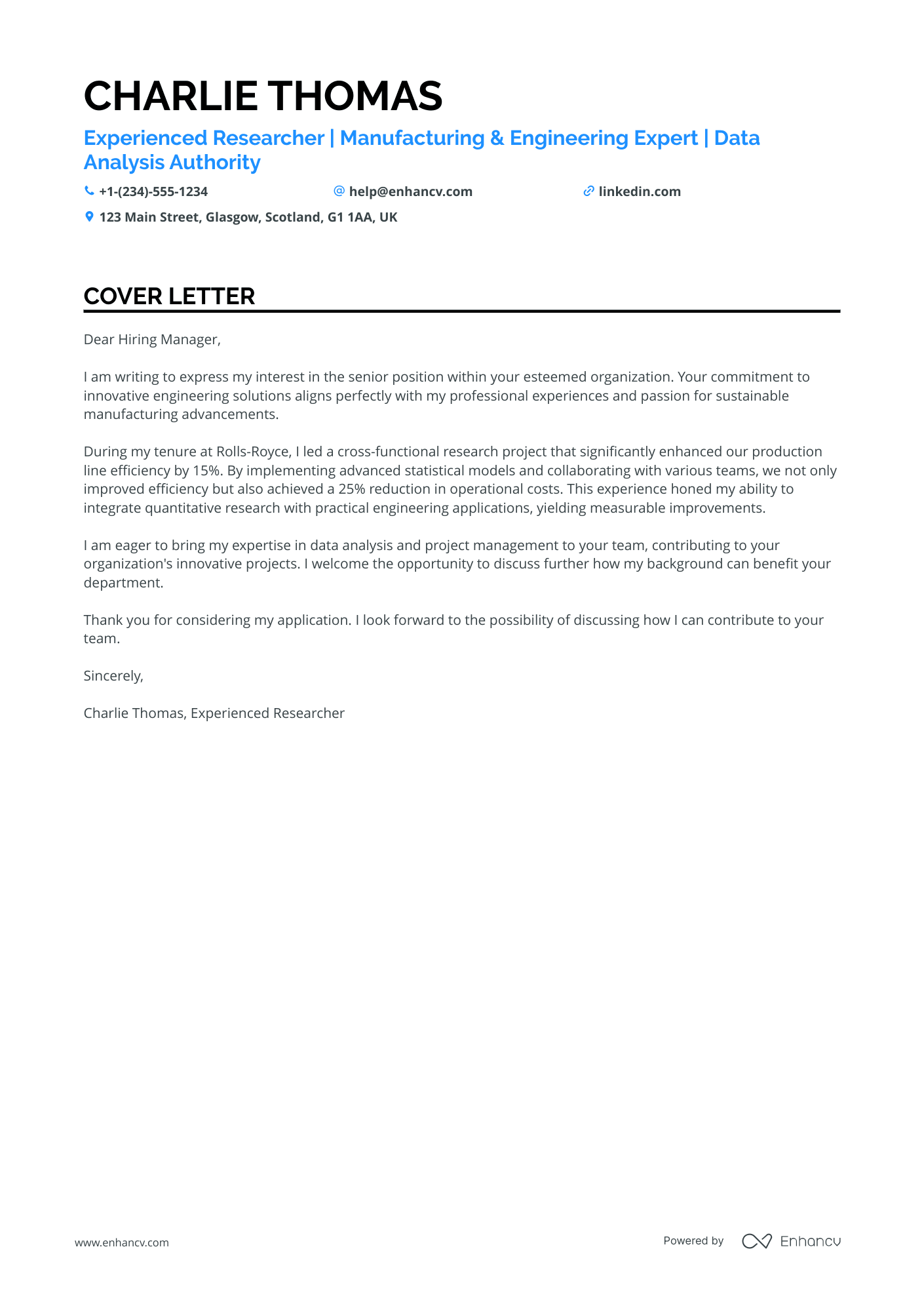Writing a strong cover letter requires close attention to detail, from the tone of voice to avoiding those pesky spelling or grammar mistakes.
Overlooking similar small details can weaken your application.
Many candidates also struggle with how to address the letter, often opting for 'Dear Sir or Madam' when they can’t find the correct contact. This can make your cover letter feel impersonal.
In this guide, we’ll show you how to perfect these crucial elements, ensuring your cover letter is polished and professional without relying on clichés.
Cover letter examples for researcher
By Experience
Senior Clinical Researcher
- The cover letter effectively highlights the candidate's ICH GCP Certification, which is crucial for ensuring compliance with international guidelines for clinical trials.
- Demonstrates the candidate's proficiency in Clinical Trials Management and Site Monitoring, which are core skills required for a Senior Clinical Research Associate.
- Emphasises successful budget negotiation and financial management skills, crucial in managing complex study budgets and ensuring timely payments.
- Showcases specific achievements such as a 15% increase in protocol compliance and a 20% reduction in approval times, demonstrating the candidate's ability to improve trial efficiency and compliance.
Junior Social Science Researcher
- Highlighting achievements that demonstrate impact, such as the 20% improvement in programme effectiveness and a 15% increase in prediction accuracy, showcases tangible outcomes of the candidate's work, which is crucial in roles focused on data-driven decision-making.
- Emphasising collaborative efforts with cross-functional teams and stakeholders illustrates the candidate's ability to work in diverse team environments, an essential skill for roles involving interdisciplinary health projects.
- Showcasing technical skills in data visualisation and machine learning, backed by specific achievements like dashboard development, supports the candidate's expertise in complex data interpretation and communication with non-technical audiences.
- Mentioning passion areas such as Public Health Innovation and Community Engagement, alongside related achievements and courses, aligns personal interests with professional expertise, contributing to a compelling narrative about the candidate's motivation and fit for the role.
Senior Financial Researcher
- Specific Achievements: Highlight significant accomplishments such as leading a project that improved trade execution efficiency by 25%, demonstrating a direct impact on business objectives and showcasing leadership ability.
- Relevant Experience: Emphasise roles and projects that align directly with the quantitative research field, such as the development of market impact models and extensive research on fixed income assets, showcasing domain expertise.
- Advanced Skills Demonstration: Highlight technical skills like Python and KDB that are crucial for quantitative roles, along with their application in reducing model calibration time and processing high-frequency trading data.
- Educational and Continuous Learning: Mention advanced degrees in Financial Engineering and Mathematics, along with relevant courses in Deep Learning and Market Impact Analysis, demonstrating a commitment to ongoing learning and knowledge enhancement in the field.
Entry-Level Environmental Researcher
- Showcasing Relevant Experience: The cover letter effectively highlights Noah Jones' extensive experience in sports data analysis and content creation, crucial for a Sports Data Specialist role.
- Emphasising Measurable Achievements: The use of statistics, such as improving audience engagement by 40% and increasing engagement with media outlets by 25%, provides concrete evidence of success.
- Highlighting Education and Certifications: The mention of a Master's degree in Sports Analytics and relevant courses like "Sports Analytics: Data-Driven Decision Making" reinforces the specialised knowledge required for the role.
- Demonstrating Passion for Industry: Noah's passion for sports technology innovation and creative writing underscores a sincere interest in advancing sports experiences, resonating well with potential employers in the field.
Lead Researcher in Data Science
- Highlighting specific achievements such as a 30% increase in user satisfaction at GOV.UK demonstrates the concrete impact made in a relevant field.
- Emphasising advanced education like a Master of Science in Human-Computer Interaction from a prestigious institution such as the University of Cambridge showcases a strong theoretical foundation.
- Discussing industry-specific methodologies, such as guerrilla testing and agile processes, underscores expertise and familiarity with modern user research practices.
- Featuring leadership and mentorship qualities, such as mentoring junior researchers and enhancing team efficiency, signals the capability to guide teams effectively within user research environments.
Junior Researcher in Human Resources
- Highlight the Advanced Psychometrics Certification from the Institute for Measurement in Education, as it underlines the specialised knowledge in psychometrics crucial for the role.
- Emphasise the 92% exam validation rate achievement, as it demonstrates a strong capability in applying psychometric techniques effectively, which is essential for a Psychometrics Specialist.
- Include the proficiency in both psychometric and data analysis, supported by a background in Psychology, as this combination of skills is highly relevant and valuable for the role.
- Address the passion for statistical analysis and technology innovation, showcasing a strong alignment with the responsibilities of advancing psychometric assessments and data-driven decisions.
Senior Researcher in Astrophysics
- Emphasising Expertise: Highlighting over 10 years of experience in cosmology and data science, indicating a deep understanding and expertise critical for a senior lecturer role.
- Showcasing Leadership and Impact: Demonstrating leadership in research, such as leading a team to increase publications by 20% and mentoring PhD students, underscores management skills and pedagogical impact.
- Proven Funding Competence: Mentioning the successful acquisition of £1.2 million in research funding establishes the candidate’s ability to secure essential resources for advanced academic research.
- Engagement and Outreach: Detailing public lectures and outreach initiatives, with a significant community impact, shows a commitment to science communication and public engagement crucial for an academic role.
Senior Researcher in Nanotechnology
- Highlighting Key Achievements: The cover letter effectively emphasizes Ruby's experience in leading projects to enhance research efficiency by 30%, demonstrating her ability to drive significant improvements in laboratory settings relevant to advanced microscopy and cell biology.
- Specific Certifications and Courses: The presence of specialised certifications such as the Super-Resolution Microscopy Certification and the Advanced Biological Imaging Techniques course highlights Ruby's expertise and commitment to excellence in the field.
- Focus on Relevant Skills and Experience: The cover letter succinctly details Ruby's hands-on experience with advanced microscopy equipment and protocols, underlining her proficiency in the technical aspects critical for a Laboratory Technical Expert role.
- Commitment to Development and Collaboration: Through examples of training programmes and interdisciplinary collaborations, the cover letter reflects Ruby's dedication to fostering a collaborative and learning-oriented research environment.
Entry-Level Researcher in Genetics
- Highlighting Oliver's experience in leading and conducting genomic analyses, which is crucial for a Research Associate position in Plant Biology and Genomics.
- Emphasising his ability to secure research funding, which showcases his capability to support and expand genomics projects effectively.
- Showcasing his published work in high-impact journals like 'Nature Plants', evidences his contributions to the field and positions him as an expert in plant genetics and gene flow dynamics.
- Illustrating his role in mentoring and supervising PhD students, underscoring his leadership skills and ability to improve laboratory productivity.
By Role
Researcher in Artificial Intelligence
- Specific Expertise: The cover letter highlights expertise in deep learning and AI with specific mention of generative models and multi-modal learning, essential for roles focused on advancing AI technologies.
- Impactful Metrics: Quantifiable achievements, such as a 30% increase in model efficiency and 35% improvement in model performance, effectively showcase the applicant's ability to deliver tangible results.
- Research Contributions: Publishing five papers in renowned AI journals underscores the candidate’s commitment to contributing to the field, a significant asset for research-oriented roles.
- Cross-Functional Collaboration: Emphasizing collaboration with interdisciplinary teams and successful project transfers into scalable solutions highlights teamwork and product development skills, crucial for innovative AI projects.
Biomedical Researcher
- Specific Research Achievements: The cover letter highlights particular research contributions, such as developing new drug delivery systems and authoring peer-reviewed papers, which demonstrate expertise and success in the field of molecular biology.
- Leadership and Mentoring: Mentioning the training and mentoring of PhD candidates reflects leadership abilities and a commitment to fostering the next generation of researchers, which is crucial in an academic and research-oriented role.
- Presentation Skills and Recognition: Winning awards for research presentations and showcasing contributions at international conferences underscore the applicant's strong communication skills and recognition in the scientific community.
- Grant Writing and Funding Success: Securing significant research funding highlights the ability to write compelling grant proposals, an essential skill for sustained research project development and departmental growth.
Educational Researcher
- Highlight Relevant Experience: The cover letter effectively includes specific experiences as a Senior Research Analyst at Rolls-Royce and a Research Engineer at BAE Systems, demonstrating a proven track record in manufacturing and engineering sectors.
- Showcase Quantifiable Achievements: It mentions quantifiable outcomes, such as a 30% increase in project efficiency and a 25% reduction in operational costs, underscoring the candidate's impact in previous roles.
- Emphasise Skills and Education: The letter succinctly outlines key skills like data analysis, statistical modelling, and risk assessment, alongside relevant educational credentials, solidifying the applicant's qualifications for the role.
- Incorporate Industry-Specific Initiatives: References to sustainable manufacturing practices and renewable energy projects highlight a commitment to industry trends and contribute to the candidate’s narrative as an innovative thinker in engineering solutions.
User Experience Researcher
- Highlight specific skills in User Research and Agile Methodologies: Emphasise experience in user-centred design, usability testing, and agile practices, which are crucial for a User Researcher role within digital services.
- Incorporate measurable achievements: Mention specific data points, such as percentage improvements in user satisfaction and adoption, to demonstrate the tangible impact of previous work.
- Detail relevant certifications and courses: Mention certifications like the Certified Professional for Usability and User Experience and courses related to Agile UX Design to showcase a commitment to professional development in the field.
- Discuss collaboration and leadership: Highlight any mentoring, team-building, or cross-departmental workshops to reflect the ability to enhance research quality and team efficiency.
Quantitative Researcher in Finance
- Experience and Accomplishments: The cover letter effectively outlines the candidate's extensive experience and achievements in quantitative analysis, derivatives pricing, and machine learning, which are crucial for a Quantitative Researcher role.
- Technical Skills: The candidate highlights key technical skills such as Python, R, and MATLAB, which are essential for data analysis and model development in this field.
- Education and Relevant Courses: The inclusion of degrees in Financial Mathematics and Mathematics from prestigious institutions, along with specialised courses, underscores the candidate's strong foundational knowledge.
- Cross-Functional Collaboration: The ability to effectively engage and lead cross-functional teams is well demonstrated, highlighting strong communication and leadership abilities vital for enhancing project outcomes.
Historical Researcher
- Specific Role-Related Experience: Explicit mention of positions held such as 'Senior Data Analyst' at Live Nation Entertainment, showcasing relevant industry experience in live entertainment.
- Tangible Achievements: Quantified successes like a 20% increase in data accuracy and 15% boost in cross-departmental efficiency, highlighting the candidate's impact.
- Relevant Education and Training: Academic background in Data Analytics and Business Management, supported by courses in Advanced Excel and Data Integrity, aligning well with data management roles.
- Key Skills and Tools: Emphasis on data analysis, data integrity, and proficiency in Excel, showcasing the critical technical skills necessary for the role.
Cyber Security Researcher
- Highlighting a percentage increase in security efficiency showcases the candidate's impact and effectiveness, which is essential for roles focused on enhancing cyber defences.
- Mentioning specific technical skills such as "Reverse Engineering" and "Scripting with Python" provides tangible evidence of the candidate's capabilities, aligning with the technical demands of a Cyber Researcher role.
- Emphasising leadership and mentoring experience illustrates the candidate's ability to not only operate within a cybersecurity team but also contribute to the professional development of others, enhancing the overall team's performance.
- Inclusion of relevant courses and certifications, such as "Advanced Network Security" and "Reverse Engineering and Malware Analysis," indicates a commitment to continuous learning, which is crucial in the evolving field of cybersecurity.
Pharmaceutical Researcher
- Relevant Experience: Highlights over 5 years of experience in B2B pharmaceutical research, showcasing a strong background that aligns well with the specified role.
- Attention to Detail: Emphasises precision in database management and data extraction which are critical skills for maintaining data integrity and efficiency.
- Impactful Achievements: Includes quantifiable achievements such as a 25% increase in project efficiency and a 30% improvement in database accuracy, demonstrating proven results-oriented performance.
- Education and Continuous Learning: Mentions relevant educational qualifications and courses, such as a Master in Pharmaceutical Sciences and completion of an Advanced Excel course, which affirm the candidate's expertise and continuous engagement with professional development.
Political Researcher
- Leveraging Experience: The cover letter effectively highlights Archie's extensive experience in political science and accountability research, which is critical for a research role in this field.
- Specific Achievements: By detailing significant achievements, such as increasing policy engagement by 40% and raising citation rates in leading journals by 25%, the cover letter demonstrates Archie's impact and potential value to a new employer.
- Relevant Skills and Tools: The mention of advanced analytical software and data visualisation skills aligns with the job requirements for research roles, emphasising Archie's technical proficiency.
- Education and Certifications: Highlighting a Master of Science in Political Science from a reputable university and certifications in advanced research methods supports Archie's suitability and expertise in handling specialized tasks in political research.
Researcher in Forensic Science
- Highlight Certifications: Emphasise certifications such as the Offensive Security Certified Professional (OSCP) as they add credibility and demonstrate a high level of expertise in application security and penetration testing.
- Feature Specific Tools and Techniques: Mentioning the design and implementation of fuzzing tools showcases technical skills and innovative contributions to application security, which are critical for a Security Researcher role.
- Quantify Achievements: Citing specific achievements such as reducing client vulnerabilities by 30% in a year effectively exhibits impact and results-oriented initiatives.
- Highlight Collaborative Efforts: Demonstrating the ability to work with cross-functional teams to remediate security flaws emphasises team collaboration skills, enhancing overall organisational security.
Researcher cover letter example
Alfie Edwards
Glasgow
+44 1234 567890
help@enhancv.com
- Highlight specific achievements or projects, such as the initiative that increased market share by 12%, to demonstrate relevant experience and impact in previous roles.
- Emphasize skills and techniques pertinent to the position, like data mining and visualization, to showcase technical expertise naturally aligned with the job requirements.
- Illustrate leadership capabilities by mentioning the role of leading a team, which is valuable for a research analyst expected to guide and influence business strategies.
- Connect personal impact to company goals, such as influencing critical strategic directions tied to revenue growth, to convey an understanding of and capability in driving business success.
Importance of cover letters in the United Kingdom
Cover letters are a vital part of professional job applications, helping shape recruiters' first impression of your profile.
Here’s why they’re important:
- Indicates your genuine interest: A well-researched cover letter reflects your knowledge of the company and role.
- Professionalism from the outset: Employers expect your cover letter to be structured, polite, and formal. If you wish to add a more personalised touch, be sure to address your recipient directly.
- Capture the recruiters' attention: For most roles, candidates tend to have rather similar experience, which is why you should use your cover letter to explain what is unique about your profile.
What UK employers expect from a cover letter
You only have one chance to impress your potential UK employers, so be wise about writing your cover letter.
When doing so, follow these three simple but essential steps:
- Do your research: Begin by researching the company and the role you're applying for. Check their website, social media pages, and relevant news to understand what drives their business.
- Highlight company values: Identify the company's core beliefs and explain how your personal and professional experiences resonate with them. For instance, if the organisation prioritises innovation, provide examples where you've demonstrated creative thinking.
- Match your skills to the job: Analyse the job description carefully and pick out the most important skills or qualifications they’re seeking. Be sure to mention your relevant achievements that prove you're the perfect fit for the position.
How to format a researcher cover letter
Your cover letter is your opportunity to make a strong impression, so its structure must be professional and clear.
Here's an overview of how a UK cover letter should be structured:
- Begin with your address and contact details at the top.
- Include the employer’s name and address directly below.
- Add the date to the left or right of the page.
- Use an appropriate greeting, such as 'Dear Mr Smith' or 'Dear Sir/Madam.'
- Open with a strong introductory paragraph.
- Develop your points in the middle paragraphs, focusing on relevant skills and experience.
- Close with a concise conclusion, reiterating your interest and suitability for the role.
- Sign off formally with your name and signature.
The software used to match your profile to the job, Applicant Tracking Systems (ATS), won’t scan your cover letter. Instead, the cover letter reads as a more personalised note to the recruiter.
When it comes to choosing a font, consider modern options like Lato, Rubik, or Chivo, which should also be applied to your CV to maintain a consistent appearance.
Additionally, your cover letter should be single-spaced with 1-inch (2.5 cm) margins on all sides (our templates are pre-set with these specifications so you can focus on your cover letter content).
Finally, always send your cover letter as a PDF to preserve the formatting and prevent edits.
How to write your researcher cover letter salutation
Imagine you're a hiring manager reading through countless cover letters—which would catch your attention: being addressed directly by name, or reading 'Dear Sir or Madam'?
The first option shows you've made the effort to learn about the company and the role.
To find the hiring manager's name, try LinkedIn, check the company's website, or even reach out to the organisation on social media.
How to write your researcher cover letter intro
It's never a bad time to show enthusiasm about the role, company, or team in your cover letter introduction.
Begin by sharing one or two aspects that genuinely excite you about the position—whether it's the company culture, specific responsibilities, or the team's past achievements.
Your enthusiasm demonstrates that you'll bring a strong work ethic, are eager to contribute, and are motivated to succeed.
How to write your researcher cover letter body
Your cover letter body is the most spacious and vital part of this document—it highlights your true value and the impact you can bring as a candidate.
Remember, your cover letter serves a different purpose to your CV. Here, you need to show your skills in context by telling the story of one significant achievement, hinting at how you’ll help your future employer achieve their goals.
So, when writing your cover letter body:
- Use concrete achievements to demonstrate your personality and impact.
- Support your achievements with quantifiable data and metrics.
- Tell the story of a successful project you’ve worked on and explain how you contributed to the outcome.
- Highlight both hard and soft skills to make your story more engaging.
- Focus on skills that are most relevant to the role and align with the company’s needs.
How to write a closing paragraph
Looking to leave a lasting impression with your cover letter closing?
Then, you should certainly end with a promise—one that outlines what you aim to achieve in the role. Ensure your goals are realistic and align with the company’s needs.
You might also include a call to action, enquiring when you can expect to hear back and what the next steps in the hiring process will be.
Conclusion
Your cover letter is an opportunity to showcase your personality and skills to potential employers. Start by addressing the hiring manager by name and tailoring your content to reflect the role’s requirements.
Include a specific example of your greatest achievement to illustrate your suitability for the position, while also expressing your enthusiasm for the company. Remember to format your letter professionally, ensuring it aligns seamlessly with your CV.


